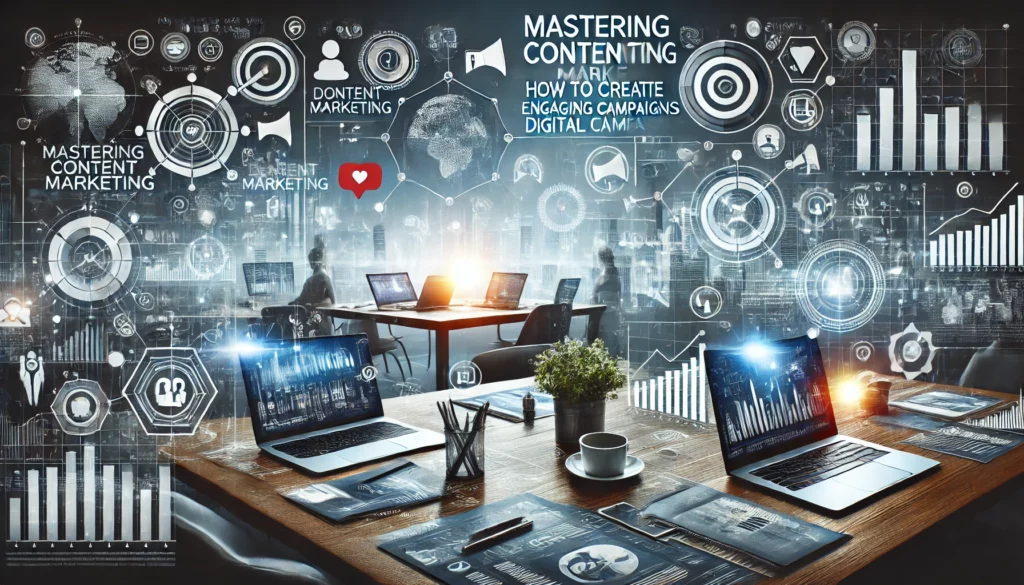
Mastering content marketing is a powerful tool in today’s digital landscape. With so many businesses vying for attention online, it’s crucial to master the art of creating engaging digital campaigns. Whether you’re a small business owner or a seasoned marketer, the key to success lies in crafting content that resonates with your audience while driving measurable results.
Mastering content in this article, we’ll explore the essential elements of content marketing and walk you through the process of creating campaigns that not only engage but also convert. From understanding your audience to leveraging SEO best practices, this guide will help you enhance your digital marketing strategy.
1. Understanding the Importance of Content Marketing
Mastering content marketing isn’t just about publishing articles or creating videos. It’s about building a relationship with your audience. In a world where consumers are bombarded with information, content marketing helps businesses stand out by providing valuable, relevant, and consistent content.
It’s a long-term strategy that focuses on building trust and credibility. And when done correctly, content marketing can drive significant ROI. But before diving into campaign creation, it’s essential to understand why content marketing matters.
1.1 Building Trust with Your Audience
Consumers today are looking for brands that understand their needs and values. Through well-crafted content, you can build a connection that fosters trust. Whether it’s through blog posts, social media content, or videos, your content should speak directly to your audience’s pain points and offer solutions.
1.2 SEO and Content Marketing
SEO and mastering content marketing go hand in hand. High-quality content that is optimized for search engines ensures that your brand is visible to the right people. By strategically using keywords, enhancing user experience, and producing relevant content, you can drive organic traffic to your website and boost your brand’s credibility.
2. Identifying Your Target Audience
Before you start creating content, you need to understand who you’re speaking to. Identifying your target audience is crucial for creating engaging digital campaigns that speak directly to their needs.
2.1 Creating Buyer Personas
A buyer persona is a semi-fictional representation of your ideal customer. By using data and research, you can create detailed personas that reflect the interests, goals, and challenges of your audience. This helps guide your content creation to ensure it resonates with the right people.
2.2 Understanding Audience Pain Points
To create content that engages, it’s important to understand your audience’s pain points. What challenges are they facing? What questions are they asking? By addressing these pain points in your content, you can provide value and position your brand as a solution provider.
3. Crafting Your Digital Campaign Strategy
Once you’ve identified your audience, it’s time to map out your digital campaign strategy. A well-planned strategy ensures your content reaches the right people at the right time.
3.1 Setting Clear Objectives
Your content marketing campaign needs to have clear, measurable objectives. Are you trying to increase brand awareness, generate leads, or boost sales? Setting clear goals helps you stay focused and ensures your content delivers the desired results.
3.2 Content Formats and Channels
There’s no one-size-fits-all approach to content marketing. Different formats—such as blogs, videos, podcasts, and infographics—serve different purposes. By determining which formats align with your objectives and audience preferences, you can create diverse content that resonates across multiple channels.
4. Optimizing Content for SEO
Creating high-quality content is important, but ensuring it’s discoverable is equally vital. Search engine optimization (SEO) helps your content rank higher on search engines, making it easier for your audience to find it.
4.1 Keyword Research
Effective keyword research is the foundation of SEO. It involves identifying the search terms your audience is using to find content similar to yours. By incorporating these keywords naturally into your content, you can improve your search engine rankings and attract organic traffic.
4.2 On-Page SEO Techniques
On-page SEO refers to the optimization of individual web pages to rank higher and earn more relevant traffic. This includes optimizing headings, using descriptive meta tags, and structuring content for readability. Additionally, ensuring fast page load speeds and mobile optimization can enhance the user experience and boost SEO performance.
5. Creating Compelling Content
Content that captivates and engages is at the heart of any successful digital campaign. It’s not just about producing content—it’s about producing the right content that resonates with your audience.
5.1 Storytelling
Humans are wired to respond to stories. When crafting your content, think about how you can weave storytelling into your strategy. Whether it’s through a customer success story, a brand narrative, or a problem-solving scenario, storytelling builds an emotional connection with your audience.
5.2 Visual Content
Visual content, such as images, infographics, and videos, can significantly enhance engagement. People are more likely to share visually appealing content, increasing your reach and driving more traffic to your website.
5.3 Creating Shareable Content
The goal is not just to get people to consume your content but to share it. By creating shareable content—whether it’s a funny meme, a helpful infographic, or a valuable resource—you can amplify your campaign’s reach and attract new followers.
6. Measuring Campaign Performance
Creating content is just the first step. To ensure that your campaigns are effective, it’s important to measure performance and track key metrics. This will help you identify what’s working and where adjustments are needed.
6.1 Key Performance Indicators (KPIs)
To evaluate your content’s success, you need to establish KPIs. Common KPIs include website traffic, lead generation, engagement rate, and conversion rate. By tracking these metrics, you can determine whether your campaign is meeting its goals.
6.2 A/B Testing
A/B testing allows you to experiment with different content formats, headlines, and strategies to see what resonates most with your audience. By testing variations of your content, you can optimize your campaigns for maximum impact.
7. Scaling Your Content Marketing Efforts
Once you’ve mastered the basics, it’s time to scale your content marketing efforts. This involves expanding your reach, increasing content production, and experimenting with new formats.
7.1 Repurposing Content
Repurposing content is a smart way to maximize your marketing efforts. You can take an existing blog post and transform it into a video, infographic, or podcast. This allows you to reach different audience segments and boost the longevity of your content.
7.2 Partnering with Influencers
Influencer partnerships can help you scale your campaigns by reaching a broader audience. By collaborating with influencers who align with your brand values, you can tap into their audience and gain more visibility.
8. Conclusion
Mastering content marketing is a continuous process of learning, experimenting, and adapting. By understanding your audience, creating valuable content, optimizing for SEO, and measuring performance, you can create campaigns that not only engage but also convert.
In today’s competitive digital world, content marketing is an essential component of any successful marketing strategy. Keep testing, stay consistent, and refine your approach to ensure your digital campaigns deliver long-term results.
FAQs
1. How can I start creating a content marketing strategy for my business?
Start by identifying your target audience, setting clear goals, and selecting content formats and channels that align with your business objectives. Consistently publish high-quality content and track your performance to refine your strategy.
2. What are the most effective content formats for digital marketing?
Popular content formats include blogs, videos, infographics, podcasts, and social media posts. The right format depends on your audience and campaign goals.
3. How can SEO help my content marketing campaigns?
SEO helps your content rank higher in search engine results, increasing visibility and driving organic traffic to your website. By using keywords, optimizing on-page elements, and improving user experience, you can boost your campaign’s effectiveness.
4. What are the best tools for content marketing?
Some popular content marketing tools include Google Analytics, SEMrush, BuzzSumo, and Hootsuite. These tools help with keyword research, content creation, social media management, and performance tracking.
5. How do I measure the success of my content marketing campaigns?
Track KPIs such as website traffic, engagement rates, leads, and conversion rates. Regularly analyze your metrics and adjust your strategy accordingly.
Read More :
